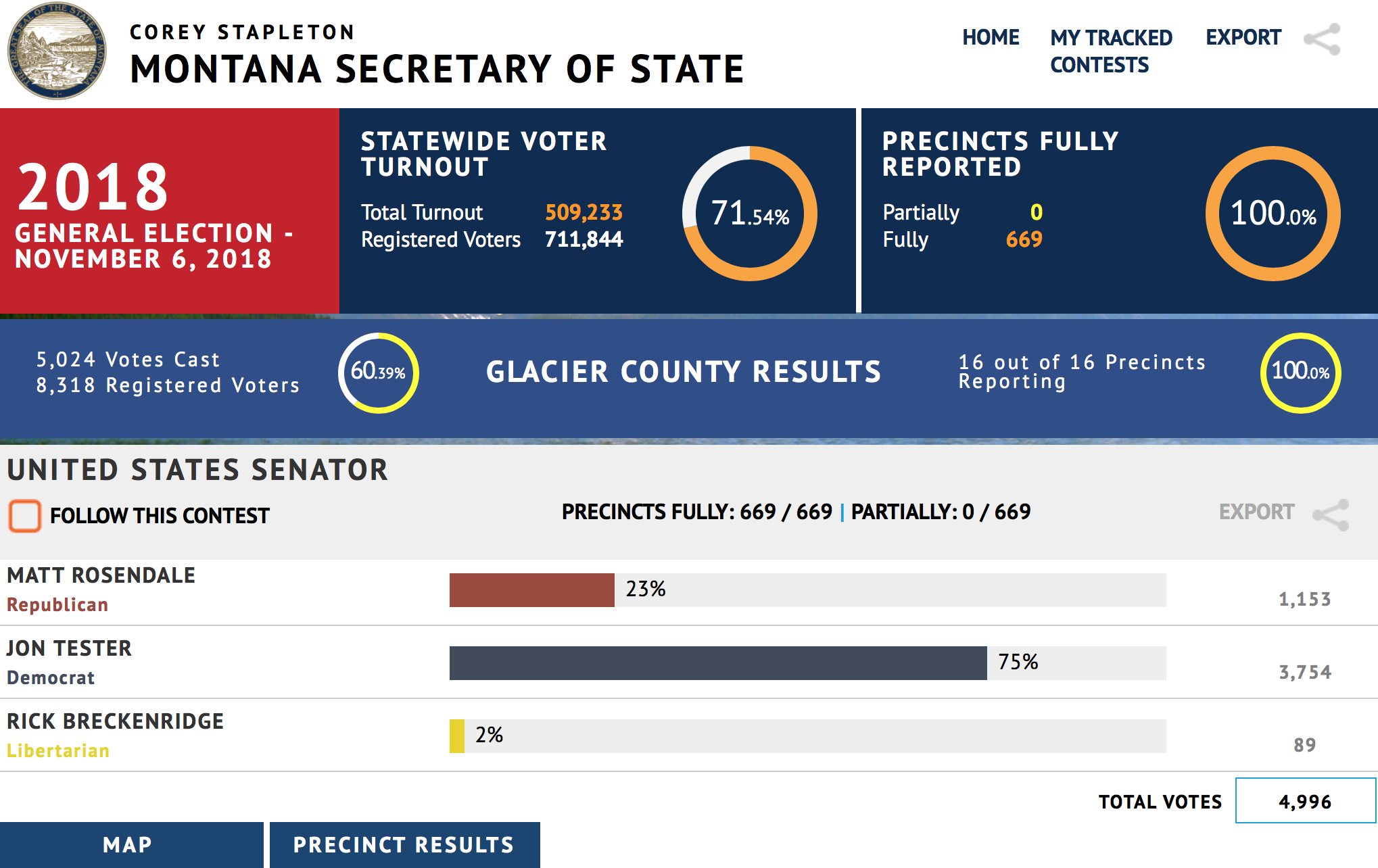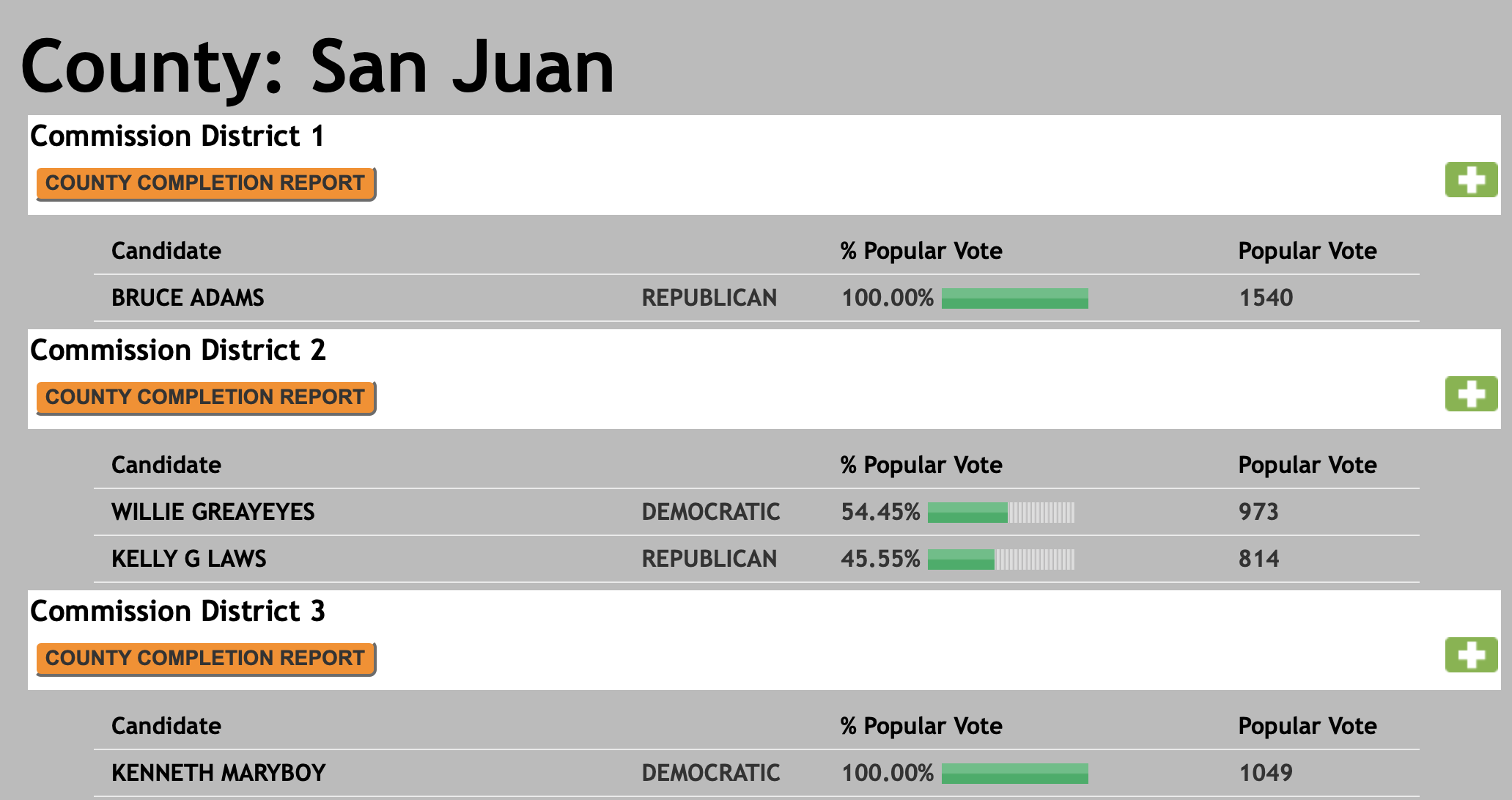What do the numbers say? Indian Country plays a unique role at the polls
Turnout was good, but it did not match voter participation during a presidential year
By Mark Trahant
Indian Country Today
indiancountrytoday.com
Now that the election is over, let’s take a tour through Indian Country’s data landscape. The country is divided into red and blue states, red for Republican, blue for Democrats. And in just about every red state, Indian Country shows up as a blue dot, an island.
And what do the numbers say? Indian Country plays a unique role, especially in rural America.
Montana Sen. Jon Tester, a Democrat, has now won three statewide races. His coalition includes Native voters, urban voters, and a small slice of Republicans who value his independence. How does this work?
Look at the unsuccessful Democrat running for the House in Montana, Kathleen Williams. She underperformed with all three groups and lost to Rep. Greg Gianforte overall by about five points -- she carried Indian Country, but by just a few points less than Tester. In
Roosevelt County, for example, a county that is majority Assiniboine Sioux and other Native people, Tester earned 68 percent of the votes compared to Matt Rosendale’s 39 percent. But in the same county, Williams had 54 percent to Gianforte’s 43 percent.
In Arizona, the coalition that helped Democrat Kyrsten Sinema defeat Republican Martha McSally followed the same path, winning Native voters throughout the state, plus rolling up large margins in Phoenix and Tucson. There is another interesting tidbit in this race: The Green Party candidate also received more than 50,000 votes -- more than 2 percent -- keeping Sinema under 50 percent.
It’s still too early to report a comprehensive look at Native voter turnout from the election, but there is some interesting early data from Indian Country using figures at the county level. The headline is that turnout was good, but it did not match voter participation during a presidential year.
 The Election Day results from Glacier County illustrate how the Native vote helps a candidate in rural areas. Source: Montana Secretary of State
The Election Day results from Glacier County illustrate how the Native vote helps a candidate in rural areas. Source: Montana Secretary of State
Montana is a great example.
Glacier County includes the Blackfeet Nation and its population is more than 63 percent tribal citizens. A little more than 60 percent of the county voters went to the polls, compared to nearly 72 percent for Montanans in general. Two years ago that turnout rate was 69 percent in that county. And how does that 60 percent compare to other midterm elections? Four years ago only 45 percent of the voters participated. (And in the midterm election before that turnout was only 34 percent.)
The
story in South Dakota shows how much work there is ahead. Oglala Lakota County had the lowest turnout in the state, at 39 percent compared to nearly 63 percent in the rest of the state. Todd County was not much higher, just under half of those registered to vote cast ballots. (Oglala Lakota County includes Pine Ridge and is 94 percent Lakota while Todd County includes Rosebud and is 85 percent Native.)
Voters from the Navajo Nation did turnout and vote. But not the same as during a presidential year. Just over half, 51.28 percent of Apache County voters (mostly Navajo citizens) cast ballots while in Navajo County the number was just shy of 59 percent. Across Arizona turnout was 60.78 percent, according to the Secretary of State’s office. Two years ago, during the presidential election cycle, Apache County was just shy of 60 percent. But four years ago, in a similar mid-year election, the turnout was 46.17 percent.
In San Juan County, Utah, where for the first time two Navajos were elected as a majority on the three-member county commission. Kenneth Maryboy easily won his district race, but in a more competitive seat,
Willie Grayeyes won by less than two hundred votes. And the turnout? Just 46.5 percent. (Utah was not much higher. That state has one of the lowest participation rates, at slightly more than 50 percent.)
 Two Native candidates won seats on the San Juan County Commission in Utah though only one of them, Willie Grayeyes, faced an opponent in the November 6, 2018, general election. Source: Elections Utah
Two Native candidates won seats on the San Juan County Commission in Utah though only one of them, Willie Grayeyes, faced an opponent in the November 6, 2018, general election. Source: Elections Utah
Across the state line in
San Juan County, New Mexico, the Native vote numbers were higher but still lower than the state’s overall turnout. The turnout rate in San Juan County was 51.54 percent while across New Mexico it was 55.4 percent. In McKinley County, which includes Gallup, parts of the Navajo Nation, and the Zuni Pueblo, turnout was 44.22 percent. (There are more Native voters in McKinley County which could reflect that difference.)
The
Navajo Nation held its election for president on the same day and the turnout for the tribal election was 64.39 percent -- significantly higher than the state totals in Arizona, New Mexico and Utah.
Alaska is another interesting contradiction. Two years ago more than 60 percent turned out to vote in the presidential election. Two years before that, partly because of ballot initiatives and partly a high profile governor’s race, turnout was 55 percent.
And this year? Unofficial Division of Elections results show that of Alaska's 571,851 registered voters, the total number of ballots cast was 236,927, a turnout of 49.1 percent.
And that’s despite another high profile governor’s race and important ballot initiatives.
The vote from Alaska Native villages was lower than that elsewhere in the state. (In fact: A twist on the map of red and blue is the state’s database uses green and yellow. Green areas show more voter participation, yellow, less.) In the Bethel region, for example, the turnout rate was 45 percent.
In North Dakota, where last minute voter ID restrictions were added, making it more complicated to vote, the tribal communities responded by increasing their participation from past elections. But it is still a lower figure than the state overall. The turnout in North Dakota was a little more than 57 percent. In Sioux County, or Standing Rock, the number was 53.34 percent. And in Rolette County, or Turtle Mountain, voter turnout reached 53.05 percent. Two years ago, voter turnout was 45.7 percent in Sioux County and 39.84 percent in Rolette County. (The data is not yet available for other tribal nations in North Dakota.)
There has been a lot of reporting about the rural, urban divide in America.
“We’ve got some big schisms out there,” said Rep. Tom Cole, Chickasaw, recently told
The Hill newspaper. The Republican won re-election R-Okla.) in an exurban and rural district on Tuesday. “Rural America’s much more Republican than ever before.”
And that's exactly right at the district level. But more and more states, especially in the West, are looking like Montana and Arizona where the urban vote has the potential to change a state, especially when Indian Country is part of a broader coalition.
Mark Trahant is the editor
of Indian Country Today. He is a member of the Shoshone-Bannock
Tribes. Follow him on Twitter @TrahantReports.
Join the Conversation



